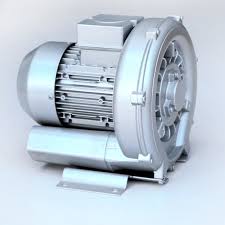Side channel blowers
A side channel blower, also known as a regenerative blower or vacuum compressor, is a type of blower that uses a rotating impeller to compress air or gas within a side channel, creating either positive pressure or vacuum. These blowers are known for their ability to generate high pressures, although they typically produce lower airflow compared to other types of blowers like centrifugal fans.
How it works:
- 1. Impeller and Side Channel:The blower’s impeller, mounted directly on the motor shaft, rotates within a specially shaped housing that creates a side channel.
- 2. Air Compression:As the impeller rotates, it draws air or gas into the side channel. The rotating impeller imparts kinetic energy to the medium, accelerating it outwards and compressing it against the side channel walls.
- 3. Pressure Build-up:The compressed gas moves through the side channel, gaining further pressure with each rotation until it exits the blower through the outlet.
- 4. Single vs. Two-Stage:Single-stage blowers complete one rotation before discharging the medium, while two-stage blowers have an additional impeller and side channel, allowing for higher pressure generation.
Key Features and Applications:
- High Pressure, Lower Flow:Side channel blowers are favored when high pressure is needed but the required airflow is relatively lower.
- Oil-Free Operation:Many side channel blowers are designed to operate without oil lubrication, minimizing the risk of contamination.
- Low Maintenance:The contactless impeller design contributes to the blower’s durability and reduced maintenance needs.
- Versatile Applications:Side channel blowers find applications in various industries, including:
- Industrial Processes: Conveying, lifting, and packaging.
- Environmental Applications: Sewage aeration, soil vapor extraction, and biogas handling.
- Food Processing: Various applications requiring suction or pressure.
- Printing and Packaging: Sheet feeding, printing, and packaging processes.
